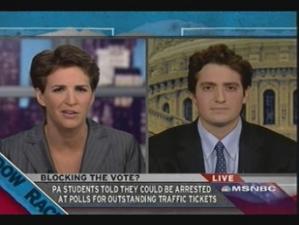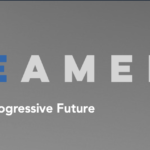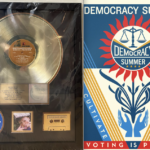From The Rachel Maddow Show Oct. 28, 2008. Rachel runs through the gamut of Republican dirty tricks to make sure that as few people vote as possible, and a key demographic they're likely to target again this year is of course the youth vote. Rachel talks to Matthew Segal about the number of young people who are likely to vote this year and what their impact might be if they're all allowed to vote. Matthew became an activist after going through the debacle at Kenyon College where students waited in line as long as ten hours to vote and where the last of them emerged as late as 4am.
It's so important that everyone band together and try to fight against as many of these tactics as we can. Whether it be warning people about the dirty tricks to drive people away from the polls so they don't fall for them to following the example of the students at Kenyon College who made sure they voted despite those lines.
MADDOW: Well it is that time in the election cycle. Having fought Barack Obama and Washington insiders and the media elite and his own party with mixed results at best, John McCain is fighting the odds. Those darn odds will beat him good. We will.
(BEGIN VIDEO CLIP)
MCCAIN: We're a few points down. The pundits wrote us up as they have several times before. I guess I'm old fashioned about these things. I prefer to let the voters weigh in before presuming the outcome. Now let's go win this election and get this country moving again.
(END VIDEO CLIP)
MADDOW: So how can McCain beat the "pundints" and the polls and every other leading indicator of his troubles without literally beating them which would hurt him politically? Basically by having a ton of people said that they are voting for Obama not vote and that, for reasoning ranging from apathy to intimidation is a real possibility. Take for example, the state of Virginia where some loveable scamp has hit the streets with this, a flyer announcing a separate election day for Democrats, the day after the real election. I would give this trickster some points to have ambition if he or she had not misspelled the word electoral. And what about that oft dreamt of youth vote? There's been a rash of creative destruction from voting officials who would prefer to dilute or discourage youth turnout. Students at Virginia Tech were told if they voted locally they could forfeit their scholarships, lose their health insurance or increase their parents' taxes. In the swing state of Pennsylvania, at Drexel University, a friendly looking note was posted warning students that undercover police officers would be at the polls on Election Day looking to make arrests for outstanding traffic offenses. All utter lies. These are voter suppression tactics and they are all factually incorrect. According to the Supreme Court which has ruled that students can vote where they go to school. If you are a student watching this show right, you can vote where you go to school. It's the law. Joining us now the Matthew Segal, the executive director for the Student Association for Voter Empowerment. Matthew, thank you very much for coming on the show.
MATTHEW SEGAL, STUDENT ASSOCIATION FOR VOTER EMPOWERMENT: Thank you for having me, Rachel.
MADDOW: The generational divide among the electorates could be more stark, younger voters, overwhelmingly favoring Barack Obama. Given the suppression efforts and given the history of young voters, I guess, enthusiasm, not translating into actual votes, apathy, which is what we've seen on Election Day, the youth vote has never come out, like, say, the senior vote or the evangelical vote. Do you believe it will different this year?
SEGAL: Young people are going to play a pivotal role this election. First off, there's every indication based on recent statistics youth voter turnout increased 11 percent among 18 to 29-year-olds from 2000 to 2004, from 2002 to 2006, both midterm elections youth voter turnout increased three percent. Then this recent 2008 season we've seen the turnout among youth double, triple and even quadruple in some states. So these enduring problems that we're facing necessitate sustainable participation and young people are delivering and will continue to deliver for decades to come, I think, now.
MADDOW: Well, your expectation about the youth vote is apparently matched by those who would prefer that it not be true, because we've seen this year a raft of voter suppression tactics aimed specifically at students. What do you think the impact is going to be of tactics like those we saw at Drexel or those we saw at Virginia Tech with voters warned in specifically studenty ways that they ought not vote at school?
SEGAL: Sure. Well, first off, it's hard to quantify how many voters these tactics will disenfranchise. But this gets to the larger issue here, that there are people that have vested interest in seeing students not be able to turn out given perhaps our political persuasion or the political affiliation that many young people tend to suggest .And then there's also this historical problem of local residents in college towns viewing college students as somehow imposing their viewpoints on them or trying to dilute their votes. But it's important to state here that college students give valuable contributions to their community. I know from my own experience as a college student that many college students go out into the local communities, volunteer. They do all sorts of area service programs. And we also help the local economy, creating jobs, dining and shopping at local restaurants and businesses. So young people very much care about their communities and they should be able to vote there. And as you pointed out, the Supreme Court affirmed that right in 1979. MADDOW: And of course we see some disproportionate impact of voter suppression efforts that are more broadly targeted on students, things like requiring a voter ID. I think the Rock the Vote poll found 19 percent of young voters don't have a government ID that has their current address, so students may be disproportionately affected by that.
SEGAL: Isn't that amazing?
MADDOW: It's incredible and it's hard to believe that it is unintentional. Let me ask you about something in 2004, though, Matthew. There is an extent to which some of this-some of the biggest problems for students feel like precincts simply being unprepared for high turnout. Either they don't believe that students are going to turn out or they really don't make preparation for a lot of students to turn out. You became an activist after waiting in line all day to vote in 2004, didn't you?
SEGAL: Sure. Yeah, well, actually, at my alma mater, Kenyon College, there were two voting machines allocated for 1,300 registered voters, one of which broke down which created disastrously long lines. Ten hours. Our final voter finished voting at 4:04 a.m. on November 3 after many networks called it for President Bush. And that created a devastating situation for first-time voters in that area. And one of my biggest anxieties this election is that with this incredible influx in student turnout, there might not be enough ballots or machines allocated to accommodate the turnout, which will result in long lines again. So it's so imperative that the precincts are equipped with emergency ballots or provisional ballots, which every voter has an unconditional right to, to make sure that these long lines don't disenfranchise young people and all Americans. Although, if you can avoid being forced into a provisional ballot situation, you should.
SEGAL: Absolutely.
MADDOW: But as a last resort. Matthew Segal, executive director for the Student Association for Voter Empowerment. Matthew, thanks very much for joining us tonight.
SEGAL: It's great to be here. Thanks and congrats on your new show.

















